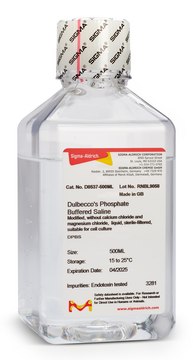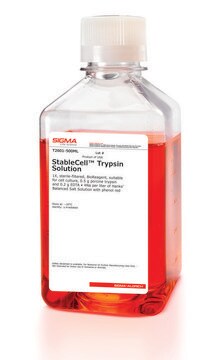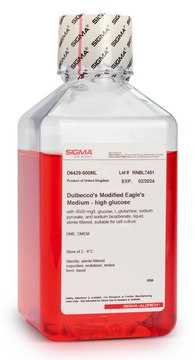T4174
Disolución de tripsina-EDTA
10 ×, sterile-filtered, BioReagent, suitable for cell culture, 5.0 g porcine trypsin and 2 g EDTA, 4Na per liter of 0.9% sodium chloride
Sinónimos:
Cocoonase, Tryptar, Tryptase
Iniciar sesiónpara Ver la Fijación de precios por contrato y de la organización
About This Item
MDL number:
UNSPSC Code:
12352204
NACRES:
NA.75
Productos recomendados
biological source
Porcine
sterility
sterile-filtered
product line
BioReagent
form
solution
mol wt
23.4 kDa
concentration
10 ×
technique(s)
cell culture | mammalian: suitable
impurities
Porcine parvovirus, none detected (9 CFR)
pH
7.0-7.6
shipped in
dry ice
storage temp.
−20°C
¿Está buscando productos similares? Visita Guía de comparación de productos
Application
The typical use for this product is in removing adherent cells from a culture surface. The concentration of trypsin necessary to dislodge cells from their substrate is dependent primarily on the cell type and the age of the culture.
Trypsin-EDTA solution is used for the following applications:
Trypsin-EDTA solution is used for the following applications:
- Used as a supplement in cell culture for their maintenance
- In harvesting cells grown to confluence
- to detach lentivirus-transduced macrophages
Biochem/physiol Actions
Trypsin cleaves peptides on the C-terminal side of lysine and arginine residues. The rate of hydrolysis of this reaction is slowed if an acidic residue is on either side of the cleavage site and hydrolysis is stopped if a proline residue is on the carboxyl side of the cleavage site. The optimal pH for trypsin activity is 7-9. Trypsin can also act to cleave ester and amide linkages of synthetic derivatives of amino acids. EDTA is added to trypsin solutions as a chelating agent that neutralizes calcium and magnesium ions that obscure the peptide bonds on which trypsin acts. Removing these ions increases the enzymatic activity.
Serine protease inhibitors, including DFP, TLCK, APMSF, AEBSEF, and aprotinin, amongst others, will inhibit Trypsin.
Serine protease inhibitors, including DFP, TLCK, APMSF, AEBSEF, and aprotinin, amongst others, will inhibit Trypsin.
Components
Trypsin consists of a single chain polypeptide of 223 amino acid residues, produced by the removal of the N-terminal hexapeptide from trypsinogen which is cleaved at the Lys - lle peptide bond. The sequence of amino acids is cross-linked by 6 disulfide bridges. This is the native form of trypsin, beta-trypsin. BETA-trypsin can be autolyzed, cleaving at the Lys - Ser residue, to produce alpha-trypsin. Trypsin is a member of the serine protease family.
Caution
This product is stored frozen between -10 and -40°C. Repeated cycles of freezing and thawing should be avoided.
Preparation Note
Incubating cells with too high a trypsin concentration for a long period can damage cell membranes and kill the cells. Solubilizing trypsin or diluting it from a concentrated solution should be done with a buffered salt solution contaiing no Ca2+ or Mg2+.
Optional
Related product
also commonly purchased with this product
Referencia del producto
Descripción
Precios
Storage Class
12 - Non Combustible Liquids
wgk_germany
WGK 1
flash_point_f
Not applicable
flash_point_c
Not applicable
Elija entre una de las versiones más recientes:
¿Ya tiene este producto?
Encuentre la documentación para los productos que ha comprado recientemente en la Biblioteca de documentos.
Los clientes también vieron
George R Wendt et al.
eLife, 7 (2018-03-21)
Schistosomes infect more than 200 million people. These parasitic flatworms rely on a syncytial outer coat called the tegument to survive within the vasculature of their host. Although the tegument is pivotal for their survival, little is known about maintenance
Nadja S Katheder et al.
Nature, 541(7637), 417-420 (2017-01-13)
As malignant tumours develop, they interact intimately with their microenvironment and can activate autophagy, a catabolic process which provides nutrients during starvation. How tumours regulate autophagy in vivo and whether autophagy affects tumour growth is controversial. Here we demonstrate, using
Guosong Qiu et al.
Journal of lipid research, 48(2), 385-394 (2006-11-10)
LPL and endothelial lipase (EL) are associated with macrophages in human atherosclerotic lesions, and overexpression of LPL in mouse macrophages is associated with a greater extent of atherosclerosis. To investigate potential mechanisms by which macrophage-derived lipase expression may mediate proatherogenic
Chiao-Chen Chen et al.
Analytical chemistry, 85(7), 3621-3628 (2013-02-21)
Elucidation of epithelial transport across transcellular or paracellular pathways promises to advance the present understanding of ion transport and enables regulation of cell junctions critical to the cell and molecular biology of the epithelium. Here, we demonstrate a new instrumental
Ricardo Rodrigues-Pinto et al.
Scientific reports, 8(1), 12866-12866 (2018-08-29)
The adult nucleus pulposus originates from the embryonic notochord, but loss of notochordal cells with skeletal maturity in humans is thought to contribute to the onset of intervertebral disc degeneration. Thus, defining the phenotype of human embryonic/fetal notochordal cells is
Nuestro equipo de científicos tiene experiencia en todas las áreas de investigación: Ciencias de la vida, Ciencia de los materiales, Síntesis química, Cromatografía, Analítica y muchas otras.
Póngase en contacto con el Servicio técnico







